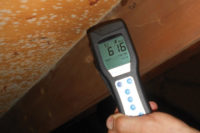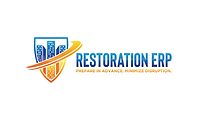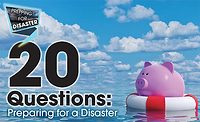Prepping for Disaster
A New Way of Doing Disaster Boardups

SecureView clearboarding installed with a bracing bar system. Photos courtesy of SecureView.
The devastation caused by Hurricanes Harvey and Irma in the U.S., and the damage inflicted on Puerto Rico by Hurricane Maria, is a grim reminder of the power of these storms and the widespread damage they leave in their wake.
Protecting the home’s windows and doors from wind and debris is the single most important step a homeowner can take to protect the structure from serious damage, according to the Federal Alliance for Safe Homes (FLASH), the country’s leading consumer advocate for strengthening homes and safeguarding families from natural and manmade disasters.
Some homeowners have installed aluminum or steel storm systems (either permanent or temporary shutters), but these systems are costly and often require approval prior to installation due to city code of HOA regulations. Many homeowners still choose to run to their local big-box retailer when the threat of a storm is looming and purchase sheets of plywood to install as a temporary boarding solution.

Florida home boarded with plywood. Photos courtesy of SecureView.
Plywood is an ineffective last resort as an emergency board-up option, according to FLASH. Plywood that is not properly attached to the house often rips off in high winds, becoming debris that can cause serious harm to properties.
Until now, homeowners had little choice other than to invest in the costly permanent shutter systems, or take their chances with the inadequate temporary solution of plywood.
Polycarbonate clearboarding is a new patented technology, pioneered by SecureView, to shield the window and door openings of properties pre-storm, and protect them post-storm. Designed to look like glass, most clearboarding is virtually unbreakable, so it can withstand hurricane-force winds, wind-driven rain and debris.
Polycarbonate clearboarding is an industrial grade sheet material extruded from polycarbonate resins. The strength and construction of polycarbonate clearboard offerings vary, however some are made from recycled materials and sheets can be as much as 200 times stronger than glass. It comes in a variety of sizes that can be easily modified onsite, using a standard circular saw, to fit any window or door opening. It is weather-resistant and, unlike plywood, will not warp, split or decay over time when exposed to wind and rain.
Clearboarding window systems are most often installed using interior clamping beams or “bracing bars” that are composed of high-density polyethylene. The bracing bars and clearboard sheet can withstand hurricane-force winds. Clearboarding can also be attached directly to the exterior window frame.

Florida home protected with SecureView. Photos courtesy of SecureView.
Post storm, clearboarding cannot be easily removed by looters or copper thieves before homeowners are able to return to their property. For first responders, precious time can be wasted in assessing interior flooding and damage when a home is barricaded with plywood. Clearboarding is transparent and speeds the efficiency of storm damage analysis.
During the post-storm clean-up process, clearboarding sheets and bracing bars can be easily removed by homeowners and placed in storage. Clearboarding is reusable, eliminating the need to purchase and install new plywood sheets in preparation for the next storm.
Besides providing pre- and post-storm property protection, clearboarding is used by property owners and mortgage servicers to secure and protect vacant properties during what is often a lengthy mortgage foreclosure process. Fannie Mae, Freddie Mac, and the VA have made game-changing decisions to eliminate the use of plywood boarding on vacant and abandoned properties by mandating the use of polycarbonate clearboarding.
While clearboarding is approximately twice the cost of plywood for materials, it is far more effective at properly securing and protecting properties. The installation costs are as cheap, or cheaper, than plywood. The economic impact of clearboarding is significant over time as the materials are reusable from hurricane season to hurricane season.
Installing clearboarding on window and door openings can mitigate damage and protect properties from the destructive forces of hurricanes. In the aftermath of the storm, properties that have been damaged are less likely to become “zombies” if measures are taken to properly secure them with clearboarding.
Looking for a reprint of this article?
From high-res PDFs to custom plaques, order your copy today!






